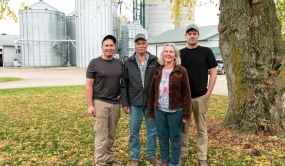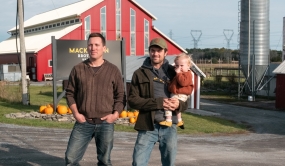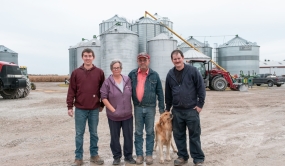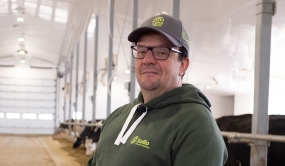Saving water, it flows from the source!
To increase their revenues and lend a helping hand with the environment while investing in the future of agriculture, producers are working on saving water.
The water saving system that Marc-André Isabelle, a graduate from McGill University in bio-resources engineering, has developed saves some 2,700 m3 of water a year (2,000 gallons per day), which is equivalent to a pit 30.5 m (100 ft) in diameter and 3.6 m (12 ft) deep. Ferme Isabelle therefore avoided the costs related to a more sizeable pit and reduced the volume for spreading manure to which fuel costs and soil compaction are also associated.
Located in Coteau-du-Lac, Ferme Isabelle is owned by Luc Isabelle, Céline Delhas and their sons Marc-André and Alexandre. Until the summer of 2010, the operation counted 48 milking cows and a finishing barn for 1,200 hogs. The crisis in the pork sector forced the family members to transform the structure of the farm.
The building with space for producing the 1,200 finished pigs was completely transformed. In its place, the dairy, an office, a workshop, a double-8 milking parlour (swing) and a water-saving system have been rearranged. Adjacent to this building, a free-stall barn has been built with production for 75 kg of quota.
In the aftermath of the renovations, the pit was maintained, which allowed for significant savings but its capacity proved to be insufficient for the dairy production needs.
To solve this problem, Marc-André set up an ingenious system that allows 1,000 gallons of water to be recovered per day and used instead for washing the assembly area for the milking parlour.
Manure from the free-stall barn is goes into the gutter. The manure and the water used to clean this part of the barn are pushed into a pre-pit where a piston pushes it to the outside pit. Having all this liquid accumulating in the pre-pit is what sparked Marc-André’s idea: “How do we recover a portion of this to use as wash water in the assembly area for the milking parlour?”
With the help of a submersible pump, a part of the liquid in the pre-pit is piped over to two tanks that are connected and can hold 1,000 gallons each. The first of the two reservoirs lets the solid portion of the manure settle to the bottom. When the tank fills with liquid, the overflow (which is made up of water with very little manure) pours into the second reservoir. The water from the second tank, with the help of a high pressure system, is used to wash the assembly area for the milking parlour. The water then returns to the gutter, then back into the pre-pit again.
To find out more, see the September 2003 issue of the Cooperateur
VIDEO IN FRENCH ONLY










